We may be compensated if you purchase through links on our website. Our team is committed to delivering honest, objective, and independent reviews on home products and services.
Project details
Skill
Cost
Estimated Time
If your bedroom is looking a little stale but you don’t want to spend a lot of cash to redecorate, consider upholstering your headboard. This simple project can add a touch of luxury to your space without costing much. In our article, we’ll explain how to upholster a headboard, common issues you might run into, and decorative elements you can include to make it unique and reflect your style.
*Unless otherwise noted, costs in this article reflect an average of prices that our team found from hardware stores like Lowes and Home Depot, and on Amazon.com.
Materials and Tools Needed for Upholstering a Headboard
Start collecting the materials and tools you need before diving into the project. By keeping these items close by, the process will be smoother and more efficient.
The materials you need include:
- 1-inch thick foam padding
- 1-by-4 pine board (for the French cleat)
- 3/4-inch plywood (cut to size for your headboard)
- Cotton batting
- Fast-drying adhesive spray
- Nailhead trim or decorative tacks
- Staples (3/8-inch)
- Upholstery fabric of your choice
- Wood screws (1 1/4-inch and 2 1/2-inch)
Here’s a list of what tools are required:
- Circular saw
- Clamps
- 1/8-inch drill bit
- Drill/driver
- Fabric shears
- Small rubber mallet
- Staple gun
- Straight edge
- Tape measure
- Utility knife
 Tape measure
Tape measure Clamps
Clamps Straight edge
Straight edge Circular saw
Circular saw Utility knife
Utility knife Fabric shears
Fabric shears Staple gun
Staple gun Small rubber mallet
Small rubber mallet Drill/driver
Drill/driver 1/8-inch drill bit
1/8-inch drill bit
Preparing to Upholster a Headboard
The image below is a diagram of what’s included in an upholstered headboard.
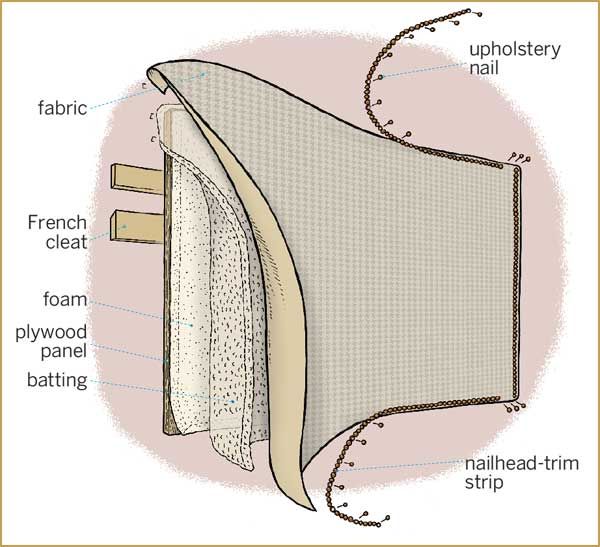
The first stage includes measuring and cutting your materials to the correct size.
Measuring and Cutting the Plywood
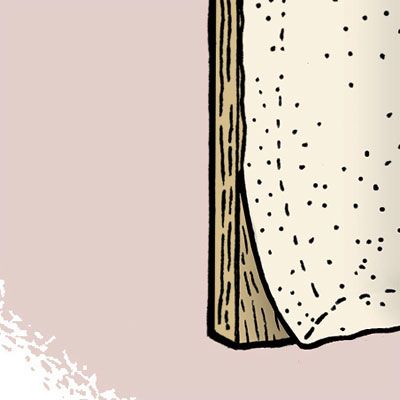
You can start by figuring out what size headboard you need. For a queen-size bed, we recommend a 60-inch-wide by 48-inch-tall headboard. Use your tape measure and straight edge to mark the dimensions on your plywood then clamp the straight edge to the plywood to guide your circular saw for a clean, straight cut.
Selecting and Cutting the Fabric
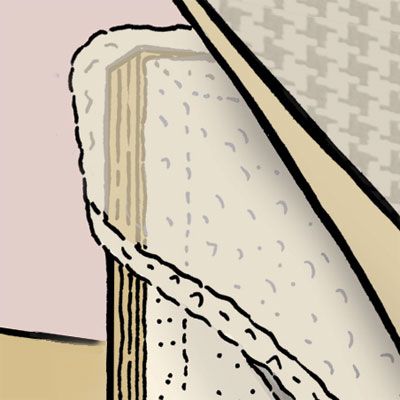
Once you’ve found a fabric that matches your bedroom décor, measure it and the batting to be 3 inches wider than the plywood panel on all sides. The extra 3 inches will allow you to wrap the fabric around the edges and secure it to the headboard’s back. If your fabric has a pattern, take extra care when you measure and cut it so that it’s properly aligned.
Creating the Padded Base
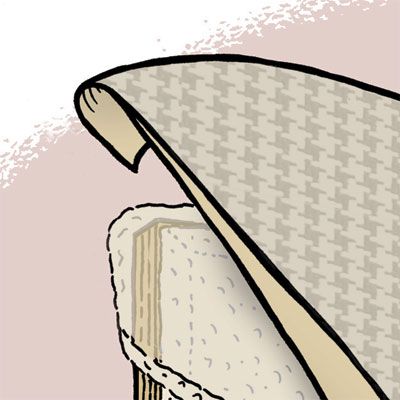
Most headboards have a padded base that gives them a soft, luxurious feel. We’ll walk you through the process of attaching the foam padding and wrapping it with cotton batting for a smooth finish.
Attaching the Foam Padding
Here are the steps to attach the foam padding:
- Lay your plywood panel on top of the foam padding.
- Cut the foam to size using a utility knife.
- Apply fast-drying adhesive spray to the plywood and one side of the foam.
- Align and stick the foam to the plywood but leave the edges unattached.
Fold the edges of the foam down to meet the plywood, creating a gentle curve around the perimeter.
Wrapping with Cotton Batting
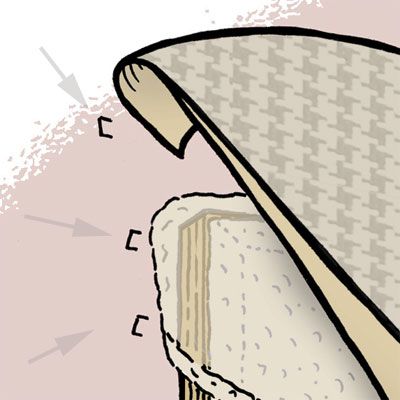
Cotton batting adds an extra layer of softness. It also helps to smooth out any flaws in the foam. To add this batting, cut it slightly larger than your padded plywood. Wrap the batting around the foam-covered panel. Make sure you pull it taut as you go. Grab your staple gun and secure the batting to the back of the plywood. Be sure to work from the center outward for even coverage.
Upholstering the Headboard
Now comes the exciting part—adding the fabric to the headboard.
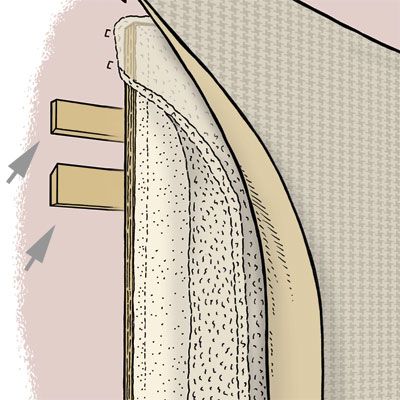
Aligning and Attaching the Fabric
By properly aligning the fabric, you’ll give it a professional look. Here’s how:
- Place your fabric face-down on a clean, flat surface.
- Center the padded headboard panel on top of the fabric. Make sure the soft side is face down and take extra care to align patterned fabric so it’s seamless.
- Pull the fabric up and over one side of the headboard as you keep it smooth and taut.
- Staple it to the back of the plywood. Start from the center and work your way out.
Stapling Techniques for a Professional Finish
Continue stapling the fabric, moving to the opposite side. Keep pulling the fabric taut as you go to avoid wrinkles or loose areas. When you reach the corners, fold the fabric to create a clean edge and staple. Work your way around the entire headboard while maintaining smooth and even fabric tension.
Adding Decorative Elements
If you’re going for a more minimalist look, you can leave the headboard, but if you want to add a little flair, consider including a decorative element. Nailhead trim is a popular choice, but there are other options too.
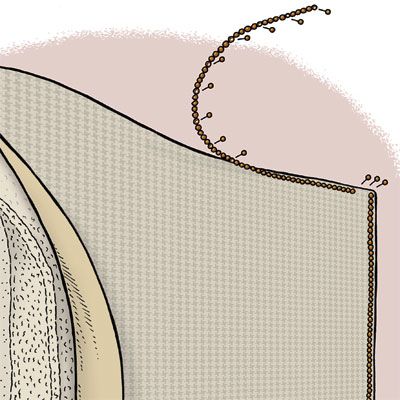
Applying Nailhead Trim
If you’ve decided to include a nailhead trim, measure and cut the trim strips to fit the perimeter of your headboard. Start at a corner and use a small rubber mallet to tap the nails into place. Work your way around the headboard while making sure it’s straight and spaced evenly.
Alternative Decorative Options
If nailhead trim isn’t your style, you can add something else, such as button tufting, decorative stitching, or a contrasting fabric border. These alternatives can add depth and interest to your headboard design.
Mounting Your New Headboard
After you’ve built your headboard, it’s time to mount it. We recommend you use a French cleat because it’s an effective and sturdy mounting method.
Creating a French Cleat
Set your circular saw at a 45-degree angle and rip a 1-by-4 pine board in half lengthwise. This creates two pieces with interlocking angles. Attach the top piece to the back of your headboard, about 6 inches from the top, using 1 1/4-inch wood screws.
Securing the Headboard To the Wall
Once you’ve made your cuts, follow these steps to secure the headboard:
- Locate and mark the wall studs where you want to hang your headboard.
- Attach the bottom half of the French cleat to the wall using 2 1/2-inch wood screws. Be sure to hit at least two studs for maximum stability.
- Lift your headboard and hang it on the wall cleat while allowing the angled pieces to interlock.
Troubleshooting Common Issues
There are a few issues you might encounter during the project. Here are the solutions to two common issues that arise when you’re upholstering a headboard.
Dealing with Fabric Wrinkles
Don’t panic if you have some wrinkles in your fabric once you’re done stapling. Simply remove the staples in the wrinkled area, smooth the fabric, and restaple it. You can use a steamer on stubborn wrinkles.
Fixing Uneven Padding
If you’ve noticed that your headboard is lumpy, it could be uneven padding. Remove the fabric and batting, and then adjust the foam padding to fix the issue. If you’re having trouble smoothing it out, try adding or removing small pieces of the foam to get a more even surface.
Upholstering Different Headboard Styles
You might need to adjust your upholstering technique depending on the style you’ve chosen for your headboard.
Wingback Headboard
A wingback headboard features panels or “wings” on the sides. This gives you a cozy and enveloping feeling when you’re in bed. If you’ve chosen a wingback headboard, measure and cut your foam and fabric to include the wings. Give extra attention when you smooth the fabric on the curved edges and corners.
Tufted Headboard
A tufted headboard has dimples or buttons in the fabric. This gives the headboard a cushioned look. Mark the locations for buttons on your headboard and pre-drill holes in the plywood. Attach the buttons by threading a needle through the fabric, foam, and wood, and then you can secure them at the back with a staple or knot.
Maintaining Your Upholstered Headboard
Keep your upholstered headboard looking fresh with our tips on cleaning and making small repairs.
Cleaning Tips
Cleaning your headboard is pretty easy. Vacuum it with an upholstery attachment to remove dust and dirt. If you notice a small stain, use a mild fabric cleaner appropriate for your fabric type but remember to test the cleaner on an inconspicuous area first to make sure it doesn’t damage the upholstery.
Repairing Minor Damage
Have a repair kit on hand for small tears or loose threads. Consider keeping any leftover fabric so that you can replace a section if you have more significant damage.
Our Conclusion
If you don’t have a lot of do-it-yourself experience, upholstering a headboard may seem daunting at first. By breaking down the process into manageable steps, it may be easier than you realize. This project gives you the control to create a custom headboard that matches your bedroom decor and personal style. Remember to be patient and use our troubleshooting tips if you run into wrinkles, uneven padding, stains, or rips.











